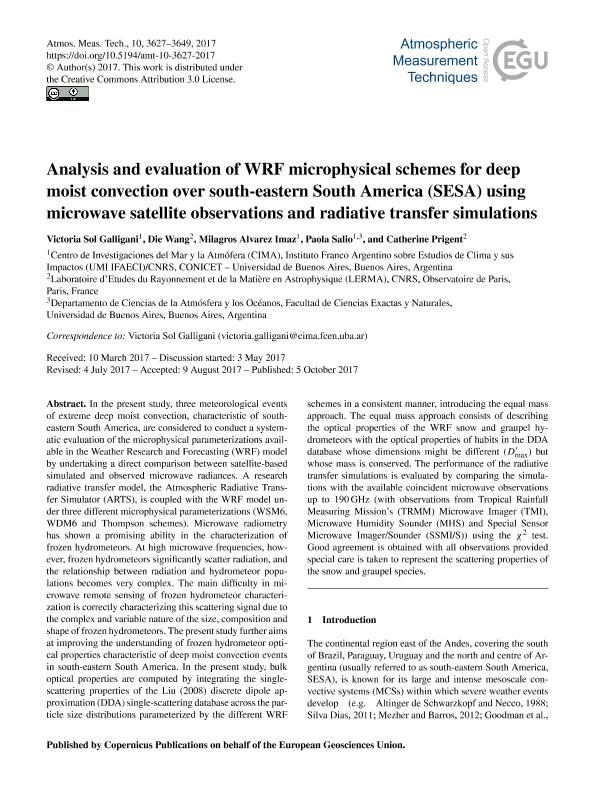Artículo
Analysis and evaluation of WRF microphysical schemes for deep moist convection over south-eastern South America (SESA) using microwave satellite observations and radiative transfer simulations
Galligani, Victoria Sol ; Wang, Die; Alvarez Imaz, María de Los Milagros
; Wang, Die; Alvarez Imaz, María de Los Milagros ; Salio, Paola Veronica
; Salio, Paola Veronica ; Prigent, Catherine
; Prigent, Catherine
 ; Wang, Die; Alvarez Imaz, María de Los Milagros
; Wang, Die; Alvarez Imaz, María de Los Milagros ; Salio, Paola Veronica
; Salio, Paola Veronica ; Prigent, Catherine
; Prigent, Catherine
Fecha de publicación:
10/2017
Editorial:
Copernicus Publications
Revista:
Atmospheric Measurement Techniques
ISSN:
1867-1381
Idioma:
Inglés
Tipo de recurso:
Artículo publicado
Clasificación temática:
Resumen
In the present study, three meteorological events of extreme deep moist convection, characteristic of south-eastern South America, are considered to conduct a systematic evaluation of the microphysical parameterizations available in the Weather Research and Forecasting (WRF) model by undertaking a direct comparison between satellite-based simulated and observed microwave radiances. A research radiative transfer model, the Atmospheric Radiative Transfer Simulator (ARTS), is coupled with the WRF model under three different microphysical parameterizations (WSM6, WDM6 and Thompson schemes). Microwave radiometry has shown a promising ability in the characterization of frozen hydrometeors. At high microwave frequencies, however, frozen hydrometeors significantly scatter radiation, and the relationship between radiation and hydrometeor populations becomes very complex. The main difficulty in microwave remote sensing of frozen hydrometeor characterization is correctly characterizing this scattering signal due to the complex and variable nature of the size, composition and shape of frozen hydrometeors. The present study further aims at improving the understanding of frozen hydrometeor optical properties characteristic of deep moist convection events in south-eastern South America. In the present study, bulk optical properties are computed by integrating the single-scattering properties of the Liu(2008) discrete dipole approximation (DDA) single-scattering database across the particle size distributions parameterized by the different WRF schemes in a consistent manner, introducing the equal mass approach. The equal mass approach consists of describing the optical properties of the WRF snow and graupel hydrometeors with the optical properties of habits in the DDA database whose dimensions might be different (Dmax′) but whose mass is conserved. The performance of the radiative transfer simulations is evaluated by comparing the simulations with the available coincident microwave observations up to 190ĝ€GHz (with observations from Tropical Rainfall Measuring Mission's (TRMM) Microwave Imager (TMI), Microwave Humidity Sounder (MHS) and Special Sensor Microwave Imager/Sounder (SSMI/S)) using the I‡2 test. Good agreement is obtained with all observations provided special care is taken to represent the scattering properties of the snow and graupel species.
Archivos asociados
Licencia
Identificadores
Colecciones
Articulos(CIMA)
Articulos de CENTRO DE INVESTIGACIONES DEL MAR Y LA ATMOSFERA
Articulos de CENTRO DE INVESTIGACIONES DEL MAR Y LA ATMOSFERA
Citación
Galligani, Victoria Sol; Wang, Die; Alvarez Imaz, María de Los Milagros; Salio, Paola Veronica; Prigent, Catherine; Analysis and evaluation of WRF microphysical schemes for deep moist convection over south-eastern South America (SESA) using microwave satellite observations and radiative transfer simulations; Copernicus Publications; Atmospheric Measurement Techniques; 10; 10; 10-2017; 3627-3649
Compartir
Altmétricas



